Classification of Buddha's teaching
There are many different classifications of Buddha teachings in Mahayana Buddhism, with different number of Yana or teachings.[1]
History
The classification of Buddha teachings is discussed very early by Mahayana Buddhists in China. In 600 AD there were 10 main classifications.[2][3]
And it continued to develop.[4][5] Kukai in Japan wrote Himitsumandara jūjūshinron (祕密曼荼羅十住心論, Treatise on The Ten Stages of the Development of Mind) and Enchin also wrote his classification.[6][7] Tibetan Buddhists also developed different classifications.[8][9]
Five Periods and Eight Teachings
Zhiyi wrote Mohe zhiguan (摩訶止觀) and Fahua Xuanyi (法華玄義). He classifies the Buddha's teaching into 5 periods and 8 teachings (五時八教). They are the Period of Avatamsaka (華嚴時), Agamas (阿含時), Vaipulya (方等時), Prajna (般若時) and Dharma-pundarika/Nirvana (法華涅槃時).
The Eight Teachings are subdivided into two groups, one is the Fourfold Doctrines of Conversion (化法四教) and the other is the Fourfold Methods of Conversion (化儀四教).
They are Tripitaka Teaching (三藏教),
Shared Teaching (通教),
Distinctive Teaching (別教),
Complete Teaching (圓教),
Sudden Teaching (頓教),
Gradual Teaching (漸教),
Secret Teaching (秘密教) and
Variable Teaching (不定教).[10]
Tiantai followed this classification.
Five Divisions and Ten Schools
Fazang wrote Huayan Yisheng Jiaoyi Fenqi Zhang (華嚴一乘教義分齊章).[11]
It classified Buddhist teachings into 5 Divisions and 10 Schools (五教十宗).
They are the teaching of sravakas (sound-hearers) (小乘教),
the elementary teaching of mahayana (大乘初教),
the final teaching of mahayana (大乘終教), the abrupt or
sudden teaching of mahayana (大乘頓教) and
the all-round or complete teaching of one vehicle (一乘圓教).
The 5 divisions are further separated into 10 schools, namely:
the reality of self and dharma (mind and matter) (我法俱有宗),
the reality of dharma, but not self (法有我無宗), dharmas have neither creation nor destruction (法無去來宗),
present dharmas are both apparent and real (現通假實宗), common or
phenomenal ideas are wrong, and fundamental reality is the only truth (俗妄真實宗),
dharmas are merely names (諸法但有宗), all Dharmas are empty (一切皆空宗),
the Bhutatathata is not unreal (真實不空宗),
phenomena and their perceptions are to be eradicated (相想俱絕宗) and the perfect, all inclusive and complete teaching of one vehicle (圓明具德宗).
[12][13] Huayan school followed this classification.
Nine yanas
There are nine yanas in Nyingma teachings. [14]
Footnotes
- ↑ 中国佛教教理
- ↑ 【报恩论坛】智者大师评判“南三北七”的意义(连载一)
- ↑ 五、六世紀中國各家的判教理論
- ↑ Preface to The Essence of Teaching and Meditation
- ↑ 1900年来佛教判教研究要述
- ↑ 空海“十住心”的判教论
- ↑ En-nin and the Japanese Tendai School
- ↑ 佛教判教
- ↑ 華嚴宗佛性 思想初探 五教佛性與心性本體
- ↑ Buddhism in a Nutshell - Chap 70
- ↑ 《华严五教章》简介
- ↑ Buddhism in a Nutshell - Chap 66
- ↑ 論文集索引
- ↑ 九乘次第論集



